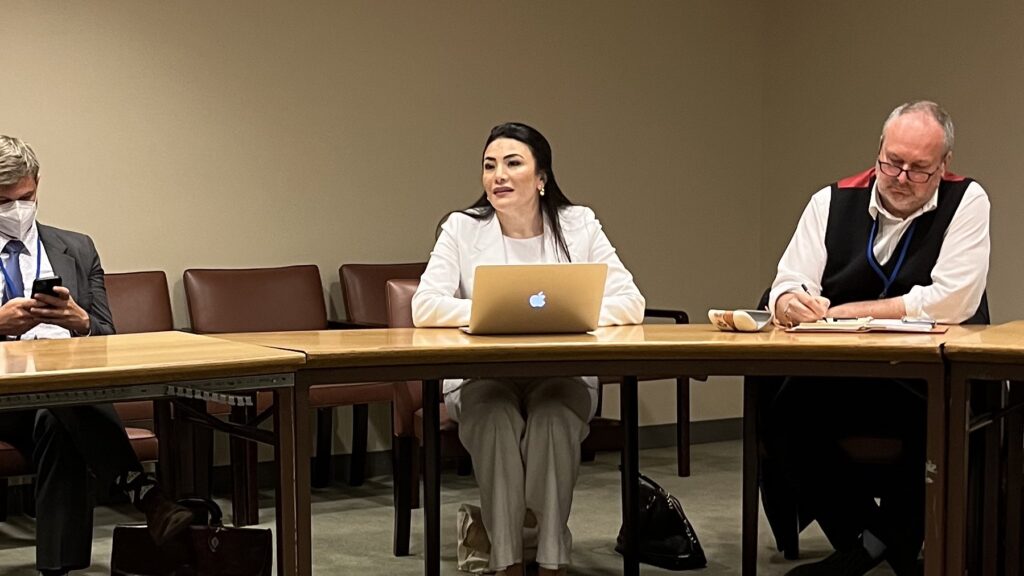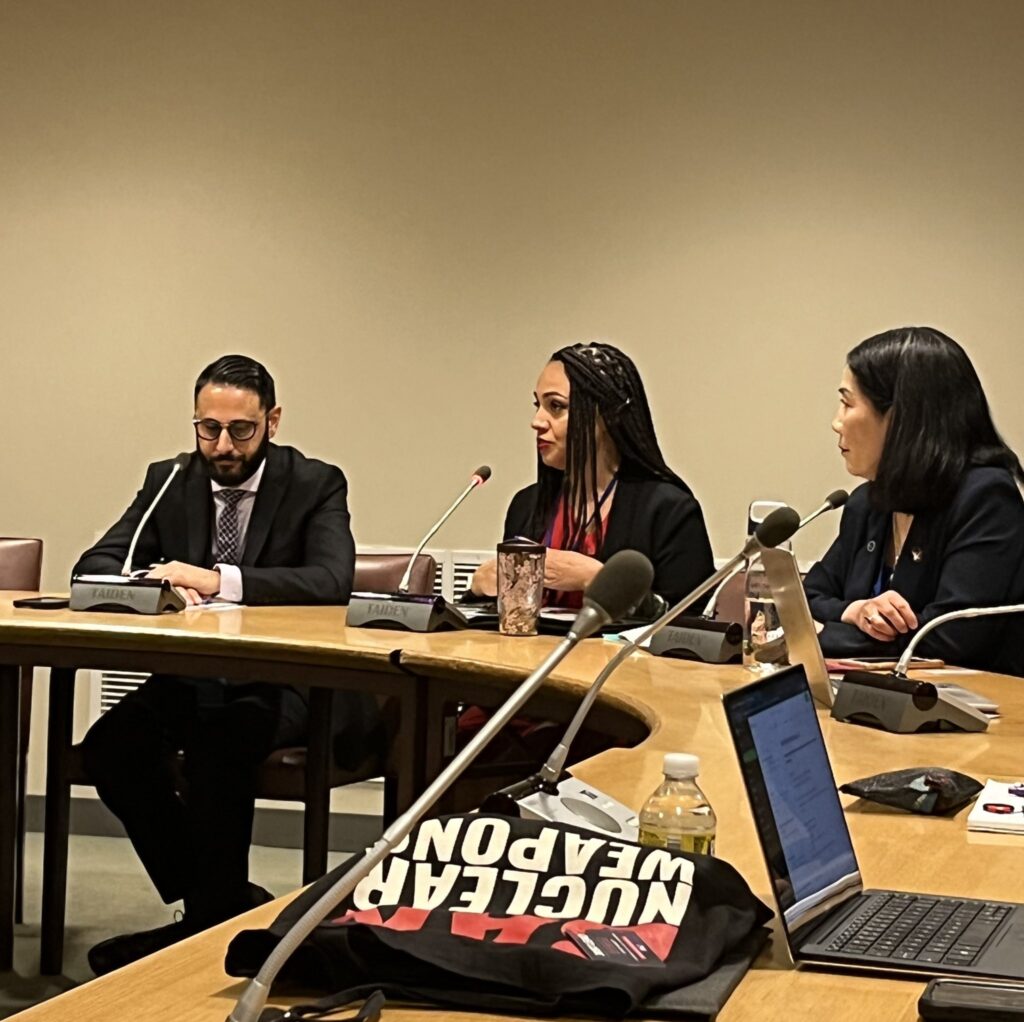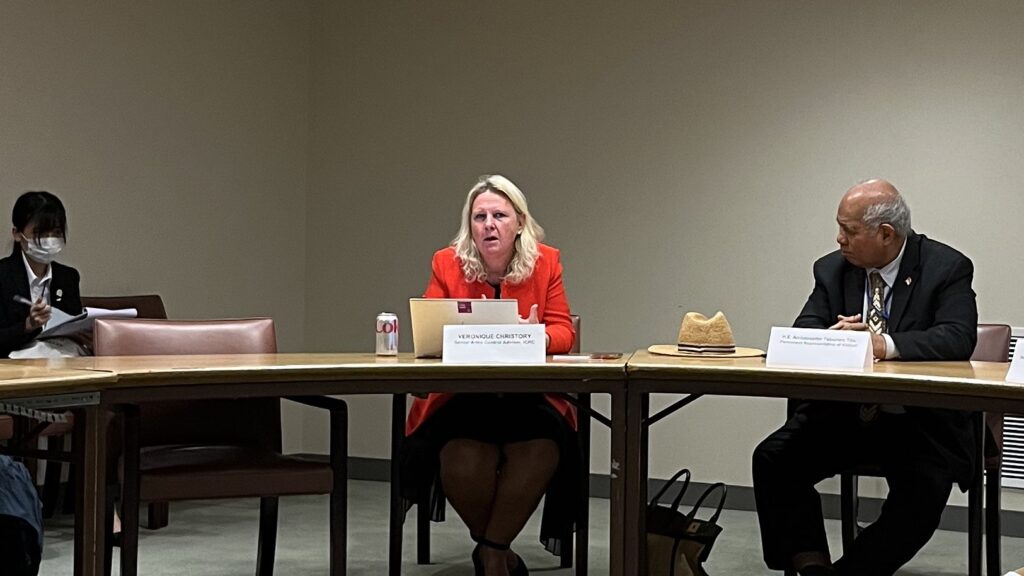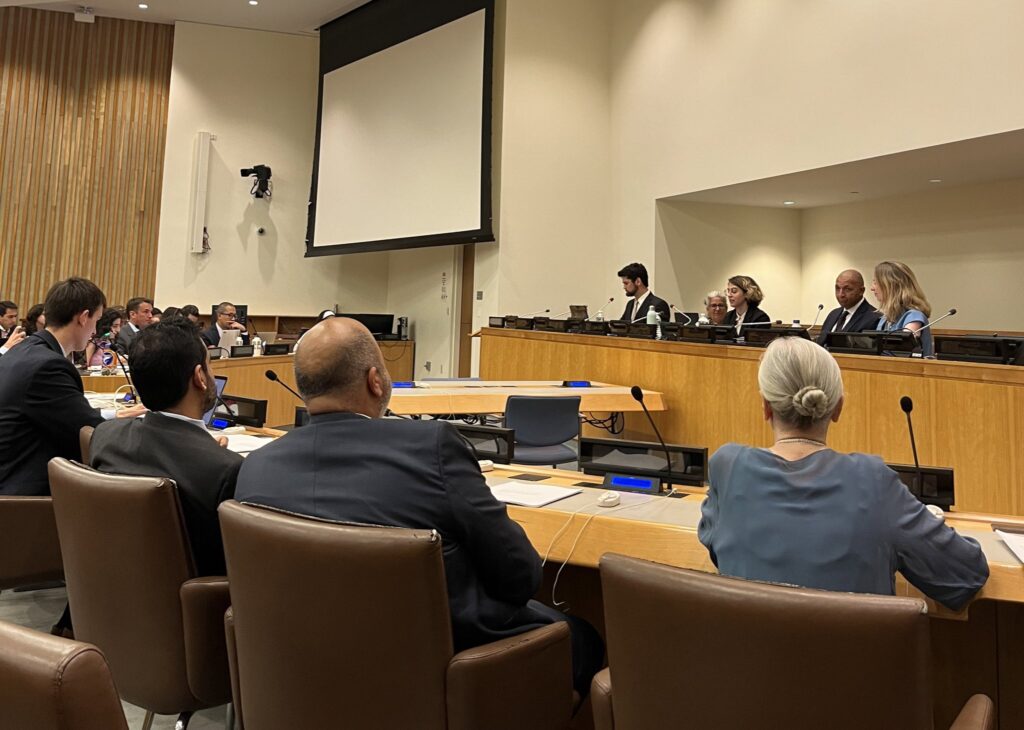
Ambassador Maritza Chan, Permanent Representative of Costa Rica to the UN, speaking at a Side Event organized by the International Campaign to Abolish Nuclear Weapons (ICAN)
What is the Tenth NPT Review Conference?
The Treaty on the Non-Proliferation of Nuclear Weapons (NPT) is an international treaty entered into force in 1970 and signed by 191 States parties that aims to promote international peace and security by preventing the proliferation of nuclear weapons and other nuclear explosive devices without hampering the benefits of the peaceful uses of nuclear energy [1]. Pursuant to Article VIII, a review of the operation of the NPT occurs five years in meetings referred to as “Review Conferences.” The NPT’s Tenth Review Conference was scheduled to take place in 2020, however, due to the unprecedented circumstances resulting from the Covid-19 pandemic, the Tenth Review Conference was postponed and officially held August 1 to 26, 2022. For more information on the outcome of the Tenth NPT Review Conference and the Final Document produced, read our summarized report here.
What are Side Events?
As articulated by the United Nations itself, “The Review Conference provides Parties with an important opportunity to reaffirm their commitment to the fullest implementation of the Treaty and the consensus outcomes of past Review Conferences, as well as to address emerging challenges and articulate a way forward” [2]. However, States parties and their delegates are not the only stakeholders allowed to participate in the Review Conferences. Members of civil society, research centers, academia, and affected communities are also provided the opportunity to actively participate in the Review Conferences as observers to certain Plenary meetings and through the hosting of Side Events. These Side Events are typically held within the room allocated to non-governmental organizations in the UN Headquarters basement, known as Conference Room B, and can be attended not only by fellow members of civil society but also by States parties’ delegates.
The purpose of Side Events is ultimately to strengthen collaboration between members of civil society and States parties, as there often exists a disconnect between the actual needs of affected communities and the solutions they desire, versus what States parties perceive to be the needs of affected communities and the solutions that are arranged at the UN. Side Events therefore serve as an opportunity for members of civil society to educate, inform, and lobby States parties’ delegates in an attempt to ensure that policies and actions pursued at the UN are representative of actual people on the ground around the world.
Though the Final Document at the Tenth NPT Review Conference was unfortunately not adopted, it is important to point out that Paragraph 151, “notes the value of positive interaction with civil society, research centres, academia and affected communities during the review cycle and greater engagement with non-governmental organizations in the context of the review process of the Treaty, as well as in the pursuit of nuclear disarmament and nuclear non-proliferation objectives” and Paragraph 155, “calls on States Parties to commit to promote and enhance the participation of civil society, including research centres and academia, in processes related to nuclear disarmament and in raising public awareness on the urgency and importance of nuclear non-proliferation and disarmament” [3]. There is hope that Paragraphs of this sort, which recognize the importance of Side Events and promote the role of members of civil society in the nuclear-decision making process, will be included in Final Documents at future Review Conferences that have the potential to be adopted.
Human Rights Now was in attendance to over 20 NPT Review Conference Side Events over the course of the Conference’s four weeks. Through live tweeting quotes and pictures from all the Side Events HRN attended, HRN aims to use social media to bridge the gap between what occurs inside of the UN basement and what civil society has access to. Though Side Events are not live-streamed on official UN platforms, quotes and pictures from all Side Events HRN attended can be found on our Twitter here. Brief summaries and pictures of select Side Events organized by topic are presented below.
Activism & Education:
Building upon the aforementioned gap that exists between members of civil society and States parties’ delegates, the Nagasaki Youth Delegation, a fully student-run Japanese NGO, organized a Side Event that explored the additional gap that exists between civil society peace activists and civil society in general. Titled, “Invisible Walls: Strengthening Bonds Between Peace Activists and the General Public,” the Nagasaki Youth Delegation discussed their mission to “convey the message, ‘the nuclear problem is your own problem” to everyone,” not just those who have been directly affected by nuclear weapons. As students themselves, the Nagasaki Youth Delegation cited the issue that students in Nagasaki know about the atomic bombings, but are missing why the voices of Hibakusha (people affected by the atomic bombings) are linked to our current situation today and the future.

The Nagasaki Youth Delegation discussing the importance of strengthening bonds between the civil society peace activists and civil society in general.
The Side Event titled, “Advancing Nonproliferation and Disarmament Education by Bolstering the Voices and Works of Women of Color,” organized by Women of Color Advancing Peace, Security and Conflict Transformation (WCAPS) also focused on addressing students’ knowledge of nuclear weapons, particularly in regards to non-proliferation and disarmament education. WCAPS explained that not only is disarmament education sorely lacking, but the disarmament education that does currently exist often fails to include “the equity lens… this idea that we can start talking about all of the existential problems happening in our world without looking at the most glaring issue, which is colonialism.” WCAPS emphasized that the shortage of diverse voices on the issues of non-proliferation and disarmament is not due to these voices not existing, but due to the reality that oppression in the form of racism, homophobia, and classism has historically prevented these voices from being involved in both the nuclear decision-making process and the nuclear disarmament movement.

Panelists advocating for diverse representation in nonproliferation and disarmament at Women of Color Advancing Peace and Security’s Side Event.
At the Side Event titled “Avoiding Nuclear War – What short-term steps can be taken?” organized by the Permanent Mission of the Republic of Kazakhstan and Soka Gakkai International, the permanent representative of Kazakhstan provided an analogy as a response to the question of solutions that can be employed to actually increase disarmament education, especially among students. Comparing the nuclear disarmament movement to the climate change movement, H.E. Mr. Magzhan Ilyassov reflected that, “many children know about climate change… but worldwide, many children do not know this topic… 25 years ago, climate change was not a topic in the UN… there was a very small group that was interested, but they managed to make it a hot topic and now children around the world know… the same can happen for nuclear disarmament.” In terms of how to make nuclear disarmament a “hot topic,” the Side Event titled, “The Role of the Arts in Nuclear Weapons Abolition: Towards the New Literacy for Peace Education,” organized by Millennium Arts Salon jointly with Western States Legal Foundation, demonstrated the ways that art can be used to inform civil society on the dangers of nuclear weapons and influence the general public to support the nuclear disarmament movement. This Side Event featured actual artists on the panel, including artist Helen Zughaib, a forcibly displaced person from Lebanon herself, all of whom emphasized that art is a form of activism that people of all cultures, nationalities, races, and gender identities can universally understand and relate to.
Humanitarian Consequences:
On the topic of universality, the Side Event titled “Article VI and the Humanitarian Impact of Nuclear Weapons,” organized by Nuclear Age Peace Foundation (NAPF) and International Physicians for the Prevention of Nuclear War (IPPNW), discussed the universality of the negative humanitarian consequences that would result from nuclear war. Citing a newly released research study that projected the effects of a nuclear war [4], Co-President of IPPNW Dr. Tilman Ruff warned that climate disruption as a result of nuclear war would produce universal negative humanitarian consequences not just for those targeted by atomic bombs but for all those living on this planet. Senior Arms Control Advisor for the International Committee of the Red Cross (ICRC) Veronique Christory emphasized that first responders and humanitarian workers are human and therefore would not be spared from facing the humanitarian consequences as a result of nuclear war. Consequently, Christory used a humanitarian argument to put forward the case for nuclear disarmament, stating “What we cannot respond to, we must prevent… we will not be able to cope with a nuclear confrontation.”

Veronique Christory, Senior Arms Control Advisor for the International Committee of the Red Cross, stressing the unmanageable humanitarian consequences that would result from a nuclear war.
Dr. Ella Faiz of IPPNW France emphasizing that “the nuclear bombs have no nationality, no sex, no religion. It would affect ALL,” at IPPNW’s Side Event.In addition to organizing the aforementioned Side Event on the humanitarian consequences of nuclear war, IPPNW also organized a Side Event titled “N-5 Doctors Speak with One Voice,” which included doctors from all nuclear-weapons States except China as panelists. Despite the current unstable international situation at the moment, particularly between the US/NATO States and Russia, all the doctors featured on the panel supported nuclear disarmament and agreed that no country in the world has the health infrastructure to handle a nuclear weapons attack, let alone a nuclear war. Unlike the Plenary meetings, where delegates from the US/NATO States and Russia disagreed on virtually everything other than the fact that they all want to keep their nuclear weapons, it was refreshing to see Dr. Olga Mironova of IPPNW Russia and Dr. Ella Faiz of IPPNW France, both agree that nuclear weapons are not good for human health and therefore must be prevented at all costs, no matter which State is in the “right” or the “wrong.”
Patricia Jaworek, Representative from Young Deep Cuts Commission and Panelist in the Deep Cuts Project’s Side Event stating that, “It is when times are tough that we need to prepare for a time when political conditions permit progress again.”
Current Affairs:
The current unstable international situation fueled by Russia’s invasion of Ukraine and the subsequent increased risk of nuclear weapons being used and/or nuclear power being abused was a focus of the Side Event titled, “Reducing nuclear risks and nuclear arsenals in times of tension in Europe,” organized by Challenges to Deep Cuts Project and the Institute for Peace Research and Security Policy at the University of Hamburg (IFSH). Though the nuclear-weapons States have an obligation to eventually disarm as required by Article 6 of the NPT [5], this Side Event recognized the threats that nuclear-weapons States present to the world at this current moment in history and proposed risk-reduction measures that can be implemented now to decrease the likelihood that nuclear weapons are actually used. These proposed risk-reduction measures include the promotion of transparency measures as proposed by Angela Kane; the commitment to developing a successor framework for New START as proposed by Daryl Kimball; and dialogue as a form of strengthening trust between States as proposed by Patricia Jaworek.
Panelists at the Side Event titled, “Nuclear Weapons in Europe” advocating against ALL nuclear weapons in European territory, including both within nuclear-weapons States territories and within NATO nuclear-sharing States.Building upon the topic of the heightened risks of nuclear weapons being used in Europe as a result of Russia’s invasion of Ukraine, the Side Event titled “Nuclear Weapons in Europe,” organized by International Peace Bureau (IPB), Nuke Free Europe (NFE), and Rosa Luxembourg Stiftung, further discussed the risks of nuclear weapons existing in Europe in the first place. Not only are the UK and France characterized as nuclear-weapons States and host nuclear weapons within their own territories, but this Side Event recognized the existence of “nuclear-sharing” among NATO members, namely Belgium, the Netherlands, Italy, and Germany, all of which host nuclear weapons for the US and which is tecnically a violation of the NPT.

Executive Director of the Middle East Treaty Organization (METO) asserting that “When this conversation stays in rooms outside of Israel or in very small rooms in Israel… nobody in Israel will even know what to say about the Zone.”
Executive Director of the Middle East Treaty Organization (METO) asserting that “When this conversation stays in rooms outside of Israel or in very small rooms in Israel… nobody in Israel will even know what to say about the Zone.”In the same way that “nuclear-sharing” technically violates the NPT and should be condemned, the Side Event organized by the Government of Ireland and the Middle East Treaty Organization discussed how Israel’s refusal to sign the NPT despite knowingly possessing nuclear weapons should likewise be condemned. Titled, “Achieving the Possible: A Middle East WMD Free Zone Draft Treaty, a regional organization and the need for an inclusive process,” this Side Event discussed the practicality of establishing a Weapons of Mass Destruction Free Zone Treaty considering the reality that Israel refuses to sign international nuclear weapons legislation and lacks transparency in regards to the nuclear weapons in its possession. Highlighting the difference between the government of Israel’s undemocratic nuclear weapons program versus the actual views of the Israeli people on nuclear disarmament, METO’s founder Sharon Dolev cited the “huge gap between human security, citizen security, and the security of the state,” and questioned, “but what is the security of that state if not the security of the people?”
Ambassador Teburoro Tito, Permanent Representative of Kiribati to the UN, declaring that, “The bigger countries talk about our security, but then don’t include us in the conversation…if we want the world to be safe, get everybody together so we can talk about common security in the Pacific together” at ICAN Australia’s Side Event.While certain States increase nuclear risks due to their actual possession of nuclear weapons, the Side Event titled “Troubled Waters: Nuclear Submarines, AUKUS, and the NPT,” organized by ICAN Australia,” discussed how even legal uses of nuclear power for the creation of non-peaceful machinery such as nuclear submarines can also increase nuclear risks. Due to the fact that universal safeguards on nuclear material used for non-peaceful activities, including space and naval propulsions, does not yet exist, Paragraph 14 of the International Atomic Energy Agency’s Safeguards Agreements 153 establishes that each State is subject to their own individual and varying safeguards [6]. This Side Event emphasized the objections presented by AUKUS States and Western solidarity States in establishing universal safeguards, as individualized application of safeguards allows certain non-nuclear weapons States aligned with the West such as Australia to engage in nuclear activities that could be disallowed in other non-nuclear weapons States. Citing the Australian government’s firm outward position in favor of the NPT and against the risks of nuclear weapons, Co-Chair of ICAN Australia Dr. Margaret Beavis pointed to Australia’s hypocrisy due to its involvement in AUKUS by stating, “Australia says it’s profoundly committed to a world without nuclear weapons, but the AUKUS proposal clearly goes against the values of the NPT.”
Japanese Liaison Council of 2nd Generation Atomic Bomb Survivors discusses the genetic (transgenerational) effects of atomic bomb radiation on 2nd generation Hibakusha through germ cells.
Victims’ Rights:
In addition to listening to the perspectives of nuclear disarmament experts, academics, and activists at Side Events, arguably the most powerful Side Events were those organized by members of affected communities themselves. The Side Event titled “Voices from the Second-Generation Atomic Bomb Survivors of Hiroshima and Nagasaki: Towards the Establishment of the Human Rights of Radiation Victims (Hiroshima) Including Future Generations and the Realization of the Nuclear-Free World,” organized by the Japanese Liaison Council of Second-Generation Atomic Bomb Survivors (JLCSGABS), featured panelists that were all second or third-generation atomic bomb survivors themselves. By sharing the trans-generation physical, social, and economic effects of the atomic bombs that the panelists first-hand experience themselves, this Side Event powerfully demonstrated that trans-generational effects of nuclear weapons are real and that second and third-generation survivors of the atomic bombs should be included in Victim Assistance measures, such as the Victim Assistance Clause of the Treaty on the Prohibition of Nuclear Weapons (TPNW) [7].
Panelists of SPARK discussing how Korean atomic bomb survivors are pursuing a People’s Tribunal to hold the US Government accountable for crimes against humanity.
Not only can Side Events organized by members of affected communities spread awareness of the issues suffered by that community and their own proposed solutions to these issues, but the Side Event titled “A Call for Justice: Recent Status of Korean Atomic Bomb Victims and Plans for the People’s Tribunal” identified members of an affected community that are typically overlooked. Organized by Solidarity of Peace and Reunification of Korea (SPARK) and People’s Solidarity for Participatory Democracy (PSPD), this Side Event discussed the existence of Korean victims and survivors of the atomic bombs, and demanded accountability from both Japan for forcibly transporting Koreans to the sites where the atomic bombs were dropped as a result of its illegal colonization of Korea, and the United States for making the decision to drop the atomic bombs on innocent civilians in the first place. The Korean panelists emphasized that accountability for past nuclear weapons use is a very important tool, “because if they got away with it one time there is more of a chance they will try to do it again.”
References:
-
Treaty on the Non-Proliferation of Nuclear Weapons, United Nations General Assembly, 5 March 1970, https://www.un.org/disarmament/wmd/nuclear/npt/text/
-
“Humanity ‘One Misunderstanding, Miscalculation Away from Nuclear Annihilation’, Secretary-General Warns as Non-Proliferation Treaty Review Conference Begins,” United Nations Meetings Coverage and Press Releases, 1 August 2022, https://press.un.org/en/2022/dc3845.doc.htm#:~:text=The%20Review%20Conference%20provides%20Parties,and%20articulate%20a%20way%20forward
-
Draft Final Document, 2020 Review Conference of the Parties to the Treaty on the Non-Proliferation of Nuclear Weapons, 25 August 2022, https://reachingcriticalwill.org/images/documents/Disarmament-fora/npt/revcon2022/documents/CRP1_Rev2.pdf
-
Xia, Lili, et al. “Global Food Insecurity and Famine from Reduced Crop, Marine Fishery and Livestock Production Due to Climate Disruption from Nuclear War Soot Injection.” Nature News, Nature Publishing Group, 15 August 2022, https://www.nature.com/articles/s43016-022-00573-0
-
Treaty on the Non-Proliferation of Nuclear Weapons, United Nations General Assembly, 5 March 1970, https://www.un.org/disarmament/wmd/nuclear/npt/text/
-
The Structure and Content of Agreements Between the Agency and States Required in Connection with the Treaty on the Non-Proliferation of Nuclear Weapons, INFCIRC/153, International Atomic Energy Agency, June 1972, https://www.iaea.org/sites/default/files/publications/documents/infcircs/1972/infcirc153.pdf
-
Treaty on the Prohibition of Nuclear Weapons, United Nations General Assembly, 7 July 2017, https://documents-dds-ny.un.org/doc/UNDOC/GEN/N17/209/73/PDF/N1720973.pdf?OpenElement



